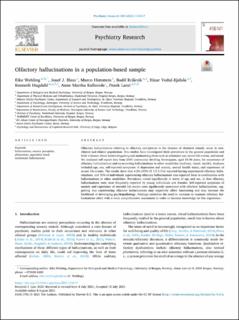| dc.description.abstract | Olfactory hallucinations referring to olfactory perceptions in the absence of chemical stimuli, occur in non-clinical and clinical populations. Few studies have investigated their prevalence in the general population and little is known about factors triggering and maintaining them such as substance use, severe life events, and mood. We analyzed self-report data from 2500 community dwelling Norwegians, aged 18-96 years, for occurrence of olfactory hallucinations and co-occurring hallucinations in other modalities (auditory, visual, tactile). Analyses included age, sex, self-reported symptoms of depression and anxiety, mental health status, and experience of severe life-events. The results show that 4.2% (95% CI 3.5-5.1%) reported having experienced olfactory hallucinations, and 56% of individuals experiencing olfactory hallucinations also reported these in combination with hallucinations in other modalities. Prevalence varied significantly in terms of age and sex, in that olfactory hallucinations were most frequently reported by young individuals and females. Self-reported symptoms of anxiety and experience of stressful life events were significantly associated with olfactory hallucinations, suggesting that experiencing olfactory hallucinations may negatively affect functioning and may increase the likelihood of developing psychopathology. Findings underline the need to continue to examine olfactory hallucinations albeit with a more comprehensive assessment in order to increase knowledge on this experience. | en_US |

